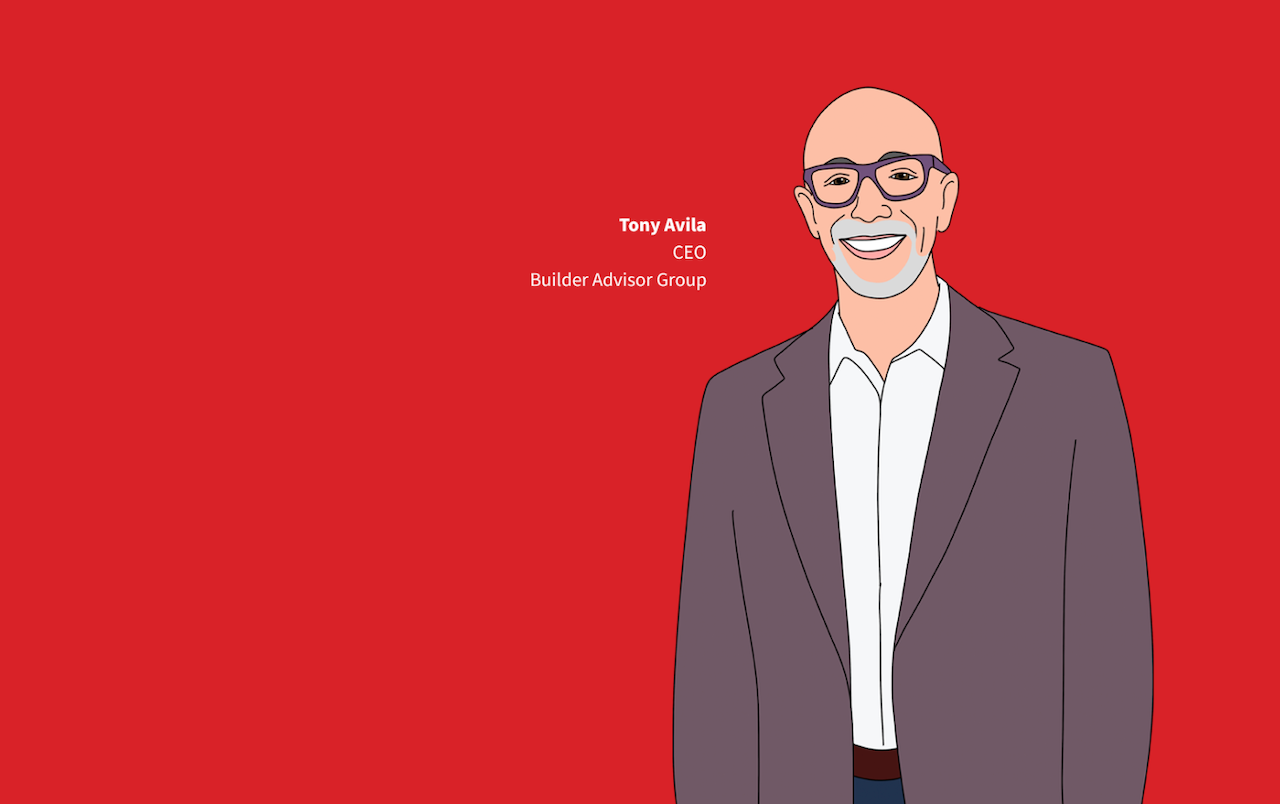Capital
Capital Optionality Is 2026's Winning Homebuilder Strategy
Tony Avila breaks down the competitive edge capital brings—and how private builders can win big in 2026’s reshaped landscape.

As 2025 draws to a close, a key theme has emerged among homebuilding strategists: advantage is concentrating at the top, and the rest of the field faces a pivotal – gut-wrenching – choice.
This defining, intensifying asymmetry weighs competitive advantage in favor of an ever-more-concentrated power base of national public enterprises and operators that make up internationally-owned portfolio companies, along with Clayton Properties.
That same asymmetry will continue to negatively affect privately capitalized operators for the foreseeable future, specifically as they now need to extend lot pipelines beyond the 2026 horizon line.
For Tony Avila, founder and CEO of Builder Advisor Group and Avila Real Estate Capital (AREC), the choice ultimately hinges on whether private builders can achieve the same level of capital access and operational agility as the nation’s top 20 to 30 homebuilders.
Avila will take the stage at The Builder's Daily Focus On Excellence Leadership Summit and Workshop (Oct. 27-29, 2025) at the Four Seasons Denver, offering data-driven insight into the most meaningful forces shaping the homebuilding land, capital, and mergers and acquisitions landscape, for 2026 and beyond.
Register now for Focus On Excellence.
The stakes are high: NAHB reports the top 10 builders now account for a record 44.7% of all single-family closings nationwide, and in many major markets, their share soars above 90%.
We are providing several strong, multi-regional growth-driven private homebuilders with a facility out of Avila Real Estate Capital," Avila says. "Certainly, a theme is diversification of private builders for their construction capital, diversifying to private lenders, of which we are one."
He continues,
Within the last eight weeks, we have closed $400 million in credit facilities for private builders. We've hired 13 people from Texas Capital Bank and Flagstar Bank. These are individuals who have previously closed their builder facilities. I'm very proud of our team."
A Shift in the Balance of Power
The M&A activity Avila tracks reflects the intensifying imbalance. He recently ran a process that drew six offers for a single builder.
Today, we have a buyer and investor group that is in excess of 60 players with whom we've received bona fide offers or closed transactions."
What's more, the investor base is global.
I was in Tokyo last week and sat down with many of the Japanese players who have already made investments, and some who are looking to make their first. We also have active conversations with investors from Korea, Canada, the Middle East, and Europe."
Why the surge? U.S. housing is arguably the largest real estate asset class globally.
If you have 700,000 homes built in a year at a $400,000 average price, that's about a $280 billion construction market annually. I don't know a bigger real estate construction industry, bigger than U.S. home building."
Private Builder Dilemma: Capital, Margins, and Land Pipelines
While the largest builders can outbid for land, lock in materials pricing, and weather margin compression, private operators face tight access to capital, rising land costs, and pressure on profitability – not to mention selling to a buyer prospect group stuck on this side of a wall of worry over economic, jobs, home values, and policy turbulence and uncertainty.
Avila sees it firsthand.
Many of our clients who are borrowing money from us have seen orders tick up in late Q3 and early Q4. We're seeing better orders compared to previous periods. That would be at the entry-level, first-time homebuyer segment."
He notes a positive trend:
Orders per community are now higher than last month's and also higher year-over-year compared with the same period the previous year. Consumer sentiment is improving slightly. Lower mortgage rates seem to be helping."
Still, private builders must make aggressive moves to prepare for 2027 and beyond.
We're doing A&D loans for private builders and private developers. We're not doing it in a land bank mode. We're just providing the debt for it. But we've been able to put about $1.2 billion to work in the last two and a half years. That's what Avila Real Estate Capital is."
2026 Economic Picture: Lower Rates, Pent-Up Demand
Avila expects the macro landscape to shift in builders' favor by mid-2026.
I expect the Fed to cut in October, and two more cuts in the first half of next year for a Fed Funds target rate of 3 to 3.25%. I expect a 10-year Treasury between 3.75 and 4%, which would imply a 30-year mortgage between 5.75% and 6%."
That could release significant pent-up demand, particularly from Millennials.
There is going to be an incredible amount of pent-up immigration of people who want to come and work and live in this country. I think we'll see some amount of easing on immigration policy after the Trump administration."
He adds,
The United States is experiencing population growth, unlike countries like Italy and Japan, which are experiencing decline. We have the millennial generation that definitely wants to own homes. That's a huge generation that needs to get housed."
Professionalizing the Operator Model
AREC isn’t just supplying capital—it's helping elevate operators.
Many of our local homebuilder clients possess a distinctive competence. It could be related to price, geography, or customer experience and satisfaction. Some have a better system, are more well-organized, or have strength in entitling and developing land, giving them a cost advantage."
That operational capability advantage – and a reliably secured network of trusted local relationships with land sellers, vendors, trades, local real estate agents, and distribution partners – is vital as builder cost pressures mount.
Some of the major builders — Lennar and NVR Ryan, specifically — have gone to subcontractors requesting 7% to 10% across-the-board cuts. BFS has honored cuts for many clients. We've seen this across subs and suppliers in the last six months."
Avila adds that NAHB has forecast a coming labor cost crisis tied to housing demand. Builders will need to run leaner, faster, and smarter.
Land Banks: One Model, Many Paths
We asked Avila whether the big-name land banks will dominate the market.
I don't think you're going to see other public companies (other than Lennar's spinoff Millrose Properties) become land bankers. I think you're just going to have that one. I don't see other homebuilding operators saying, 'That's a great model, let's do it.' Land bankers serve a purpose. There's definitely strong demand there."
He adds, addressing the fact that most of the land banking currently being done impacts enterprise-level national players who do a high-volume business in land acquisition,
You'll see more reaching down. As land banking becomes more prevalent, they'll reach down to more clients."
The Road to 2027: Planning Now or Paying Later
For private builders, 2027 is already a looming deadline to shore up land pipelines, restructure capital stacks, and rebalance risk.
We're absolutely going to be there," Avila says. "We're stepping in where the banks have pulled back. We’re helping our clients plan land pipelines and secure capital so they’re not left flat-footed in the next cycle."
A Reason to Be in Denver
Avila’s perspective is rooted in decades of experience, spanning multiple cycles, continents, and builder profiles. His session at Focus On Excellence will go deep into what operators and strategic leaders need to understand and act on in real time to stay relevant in a fast-shifting competitive landscape.
Be there. Register now.
If you're a homebuilding executive leading capital strategy, land acquisition, or operational direction, you won't want to miss it.
MORE IN Capital
How Developers Can Miss Millions In Infrastructure Recovery
Too many landowners front infrastructure costs without a plan to get paid back. Carter Froelich explains how to set up recovery mechanisms early — before it’s too late.
Toll Brothers Exits Apartments, Sharpens Playing To Strengths
The $347 million sale of Toll Brothers’ Apartment Living platform to Kennedy Wilson transfers $5.2 billion in assets under management and a national development team. For Toll, it’s less about retreat than an embrace of its cultural pedigree of focus, discipline, and luxury market leadership.
Stanley Martin Grows Southeast Footprint With Windsor Homes
The North Carolina builder brings 2,100 lots and 270 homes into Stanley Martin’s fold, extending its reach across the Triad and coastal markets. For Daiwa House, the deal is another step in building regional “mini Daiwa Houses” as durable U.S. platforms.


